Published the 5th consecutive article in the American Chemical Society
The Department of chemistry has always been a dynamic space for innovative and inspiring research. Recently, Assistant Professor Dr Nimai Mishra published his fifteenth research paper from SRM university-AP as a corresponding author. The paper is titled Post-synthesis Treatment with Lead Bromide for Obtaining Near Unity Photoluminescence Quantum Yield and Ultra-Stable Amine Free CsPbBr 3 Perovskite Nanocrystal and is published in the Q1 journal, The Journal of Physical Chemistry C with an impact factor of 4.2. The research group is comprised of Dr Mishra’s PhD students Mr Syed Akhil, Dr V G Vasavi Dutt, and Mr Rahul Singh. This is the group’s fifth consecutive article published in the American Chemical Society.
About the article
 The article reports Ultra-Stable and Near Unity Photoluminescence Quantum Yield Amine Free CsPbBr 3 Perovskite Nanocrystal Post-synthesis Treatment with Lead Bromide. Herein, the researchers have introduced a simple lead bromide (PbBr 2 ) post-treatment process to achieve the near-unity PLQY (>95 %) in amine-free CsPbBr 3 PNCs. Furthermore, PbBr 2 treatment enables these materials to drastically improve stability in different environmental conditions (polar solvents, light, and heat). In addition, a green-emitting down- converted light-emitting diode was fabricated using PbBr 2 treated amine-free CsPbBr 3 PNCs, which shows its considerable prospects for display applications. Thus, the results of the research will promote these PbBr 2 treated amine-free inorganic perovskite nanocrystals for commercial development in optoelectronic applications.
The article reports Ultra-Stable and Near Unity Photoluminescence Quantum Yield Amine Free CsPbBr 3 Perovskite Nanocrystal Post-synthesis Treatment with Lead Bromide. Herein, the researchers have introduced a simple lead bromide (PbBr 2 ) post-treatment process to achieve the near-unity PLQY (>95 %) in amine-free CsPbBr 3 PNCs. Furthermore, PbBr 2 treatment enables these materials to drastically improve stability in different environmental conditions (polar solvents, light, and heat). In addition, a green-emitting down- converted light-emitting diode was fabricated using PbBr 2 treated amine-free CsPbBr 3 PNCs, which shows its considerable prospects for display applications. Thus, the results of the research will promote these PbBr 2 treated amine-free inorganic perovskite nanocrystals for commercial development in optoelectronic applications.
Explanation of the research
Cesium lead halide perovskite nanocrystals (PNCs) have been the flourishing area of research in the field of photovoltaic and optoelectronic applications because of their excellent optical and electronic properties. Mainly, cesium lead bromide (CsPbBr 3 ) NCs with bright green photoluminescence (PL) and narrow full-width at half-maximum (FWHM) of < 25 nm is the most desirable for television displays and green-emitting LEDs. Improving the photoluminescence quantum yields (PLQYs) and optimizing the stability have been challenging tasks to promote cesium lead halide (CsPbX3; X=Cl, Br and I) perovskite nanocrystals (PNCs) for real optoelectronic applications. In recent years, the amine- free synthesis route has become an option for making stable CsPbX 3 PNCs.
- Published in Chemistry-news, Departmental News, News, Research News
Optimised copper nanoclusters for bio imaging applications
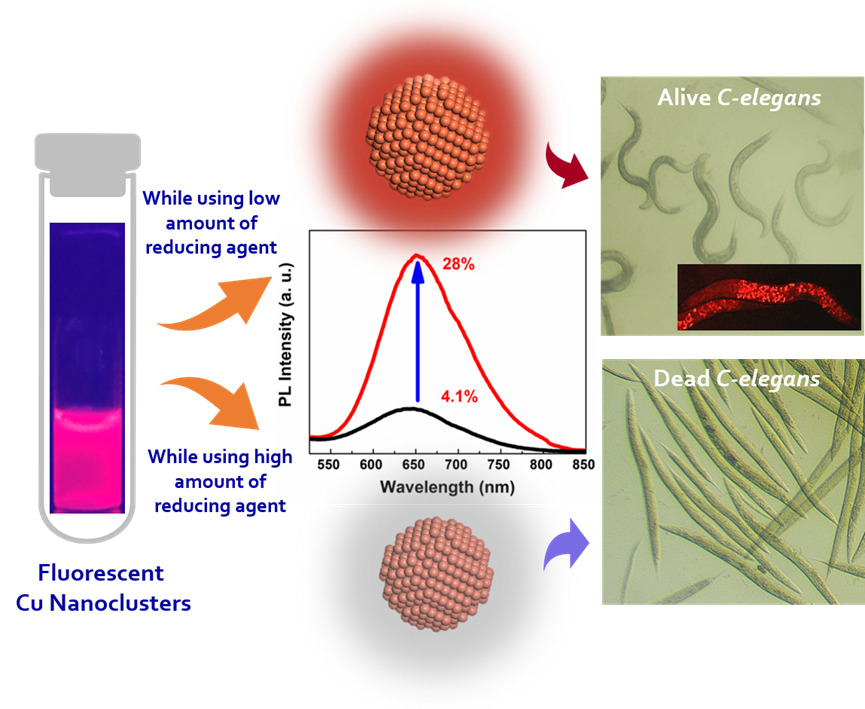
Inspite of being a plentiful and inexpensive metal, the use of copper nanoclusters is limited in bio-medical research because of their toxicity and low stability due to its easily oxidizable nature. It also has a low quantum yield. The interdisciplinary publication of the researchers at SRM University-AP successfully addressed these constraints, resulting in strong fluorescence, superior colloidal stability, and non-toxicity of copper nanoclusters for bio imaging applications. The research was a collective work of Dr Manjunatha Thondamal from the Department of Biological Sciences, Dr Mahesh Kumar Ravva and Dr Sabyasachi Chakrabortty from the Department of Chemistry along with their PhD scholars; Mr Kumar Babu Busi, Ms Kotha Jyothi, Ms Sheik Haseena, Ms Shamili Bandaru and Ms Jyothi Priyanka Ghantasala.
The article titled ‘“Engineering colloidally stable, highly fluorescent and nontoxic Cu nanoclusters via reaction parameter optimization” was featured in the prestigious Q1 journal RSC Advances (IF: 4.036), published by the ‘Royal Society of Chemistry’. They successfully prepared the protein stabilised copper nanoclusters inside the aqueous medium with exceptional optical properties. To the best of their knowledge, the reported colloidal stability and quantum yield of their as-synthesized Cu NCs are the highest reported in the literature, where the emission wavelength is in the red region. Also, optimised copper nanoclusters showed excellent biocompatibility towards solid cancer cell lines and C. elegans as in vitro and in vivo environments. Thus, these red colour luminescent copper nanoclusters were becoming a suitable fluorescent probe for deep tissue penetration, photodynamic, photothermal and diagnostic applications.
Abstract of the Research
Metal Nanoclusters (NCs) composed of the least number of atoms (few to tens) became very attractive for their emerging properties owing to their ultrasmall size. Preparing copper nanoclusters (Cu NCs) in an aqueous medium with high emission properties, strong colloidal stability, and low toxicity has been a long-standing challenge. Although they are earth-abundant and inexpensive, they are comparatively less explored due to their limitations such as ease of surface oxidation, poor colloidal stability, and high toxicity. To overcome these constraints, we established a facile synthetic route by optimizing the reaction parameters, especially altering the effective concentration of the reducing agent to influence their optical characteristics. The improvement of photoluminescence intensity and superior colloidal stability was modelled from a theoretical standpoint. Moreover, the as-synthesized Cu NCs showed a significant reduction of toxicity in both in vitro and in vivo models. The possibilities of using such Cu NCs as a diagnostic probe towards C. elegans were explored. Also, the extension of this approach towards improving the photoluminescence intensity of the Cu NCs on other ligand systems was demonstrated.
- Published in Biology News, Chemistry-news, Departmental News, News, Research News
Charge transfer in photoexcited cesium lead halide perovskite nanocrystals

The Department of Chemistry is glad to announce that Assistant Professor Dr Nimai Mishra and his research group Manoj Palabathuni, Syed Akhil, and Rahul Singh have published an article titled “Charge Transfer in Photoexcited Cesium Lead Halide Perovskite Nanocrystals: Review of Materials and Applications” in the Q1 journal “ACS Applied Nano Materials ” published by The American Chemical Society. The journal has an Impact Factor of 6.14.
Cesium Lead Halide (CsPbX3) perovskite nanocrystals (PNCs) have attracted significant views from researchers due to their essential optoelectronic properties, especially long charge carrier transfer, high efficiency in visible light absorption, and long excited states lifetime, etc. Because of these properties, these materials exhibit outstanding charge transfer and charge separation, which enables them for solar cell applications. Recently, cesium lead halide perovskites have emerged as photocatalysts. In photovoltaics or photocatalysis, upon photoexcitation, the exciton dissociates, and the electron/hole is transmitted from the conduction/valance bands to the electron/hole acceptors. Therefore, it is essential to understand how the charge transfer occurs at the PNCs interface, which can help the researcher maximize the output in solar cells and photocatalytic efficiency.
In this article, Dr Mishra’s research group has outlined different charge transfer dynamics based on critical factors and discussed their optoelectronic properties. Electron/hole transfer dynamics are the most concerning characteristic; thus, they reviewed the relevant literature that reported efficient electron/hole transfer performance. In the end, they highlighted the recent development of the use of perovskite nanocrystal as photocatalyst in organic synthesis.
- Published in Chemistry-news, Departmental News, News, Research News
PhD scholars attended the INUP-i2i Familiarisation Workshop at IIT Kharagpur
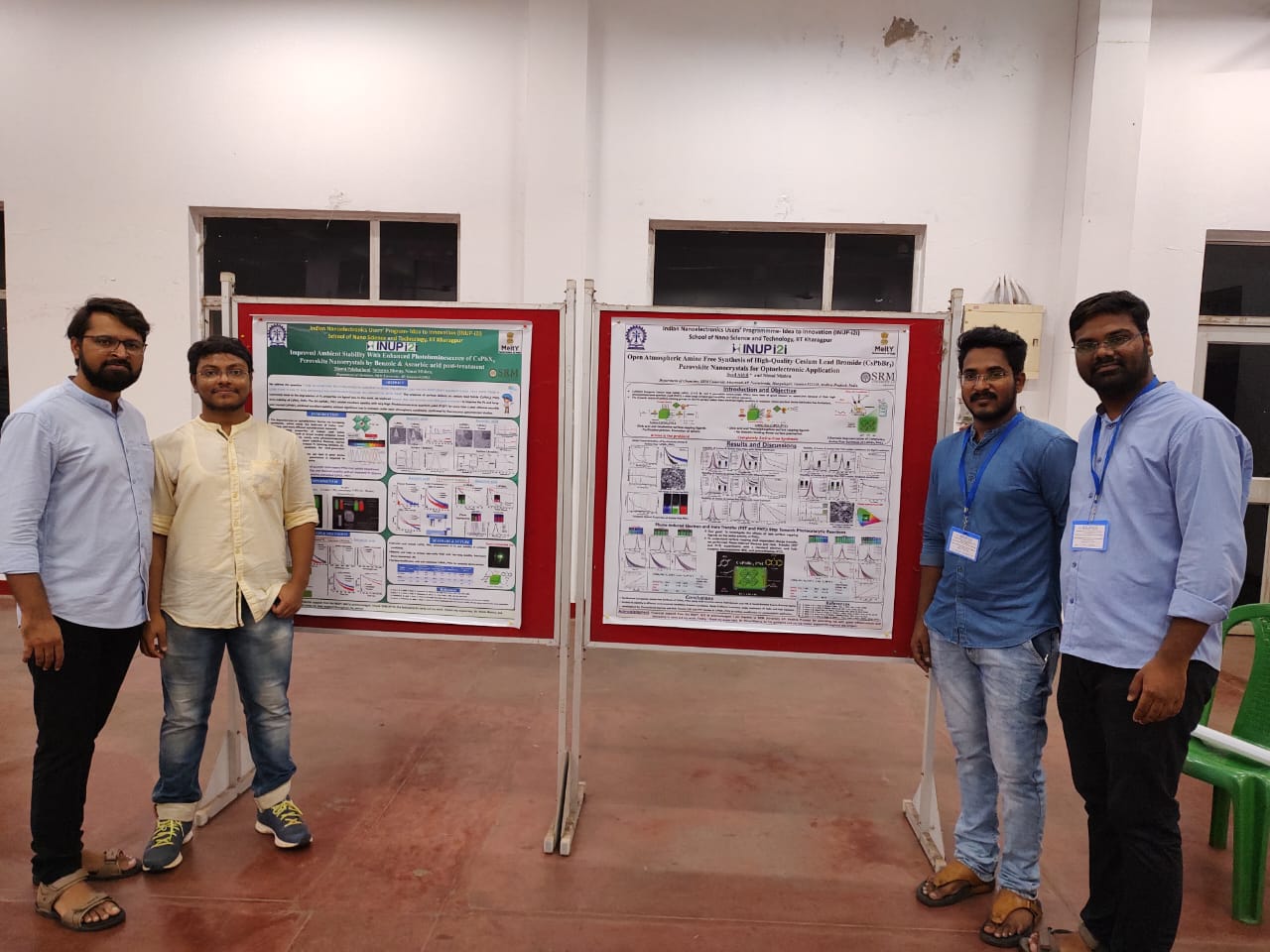 The Ministry of Electronics and Information Technology (MeitY) established the Indian Nanoelectronics User’s Programme (INUP) about a decade ago with the intention of improving skilled manpower in the areas of micro and nanoelectronics. This has laid the necessary foundation for the next step of the programme, INUP-i2i. It is a matter of pride that four PhD students from the Department of Chemistry attended the INUP-i2i Familiarisation Workshop on Nanofabrication and characterisations held from August 10 to 12, 2022, at IIT Kharagpur. Mr Syed Akhil, Mr Rahul SIngh, Mr Manoj Palabathuni, and Mr Subarna Biswas are the scholars who have grabbed this incredible opportunity.
The Ministry of Electronics and Information Technology (MeitY) established the Indian Nanoelectronics User’s Programme (INUP) about a decade ago with the intention of improving skilled manpower in the areas of micro and nanoelectronics. This has laid the necessary foundation for the next step of the programme, INUP-i2i. It is a matter of pride that four PhD students from the Department of Chemistry attended the INUP-i2i Familiarisation Workshop on Nanofabrication and characterisations held from August 10 to 12, 2022, at IIT Kharagpur. Mr Syed Akhil, Mr Rahul SIngh, Mr Manoj Palabathuni, and Mr Subarna Biswas are the scholars who have grabbed this incredible opportunity.
Indian Nanoelectronics User’s Programme- Idea to Innovation (INUP-i2i) is developed to facilitate and support the generation of expertise in Nanoelectronics through participation and utilisation of the facilities at Nano-centres at IISc Bangalore, IIT Bombay, IIT Delhi, IIT Kharagpur, IIT Madras, and IIT Guwahati.
INUP will provide easy access to state-of-the-art nanofabrication and characterisation facilities to researchers, thereby creating a critical mass of hands-on experimental researchers across the country. This workshop is being organised both for familiarisation and interaction of the participants with faculty members of IITKGP. INUP has provided the accommodation and food for these shortlisted students. At the end of the workshop, they presented a poster as well.
- Published in Chemistry-news, Departmental News, News, Students Achievements
Faculty Development Programme on Recent advancements in Materials Chemistry
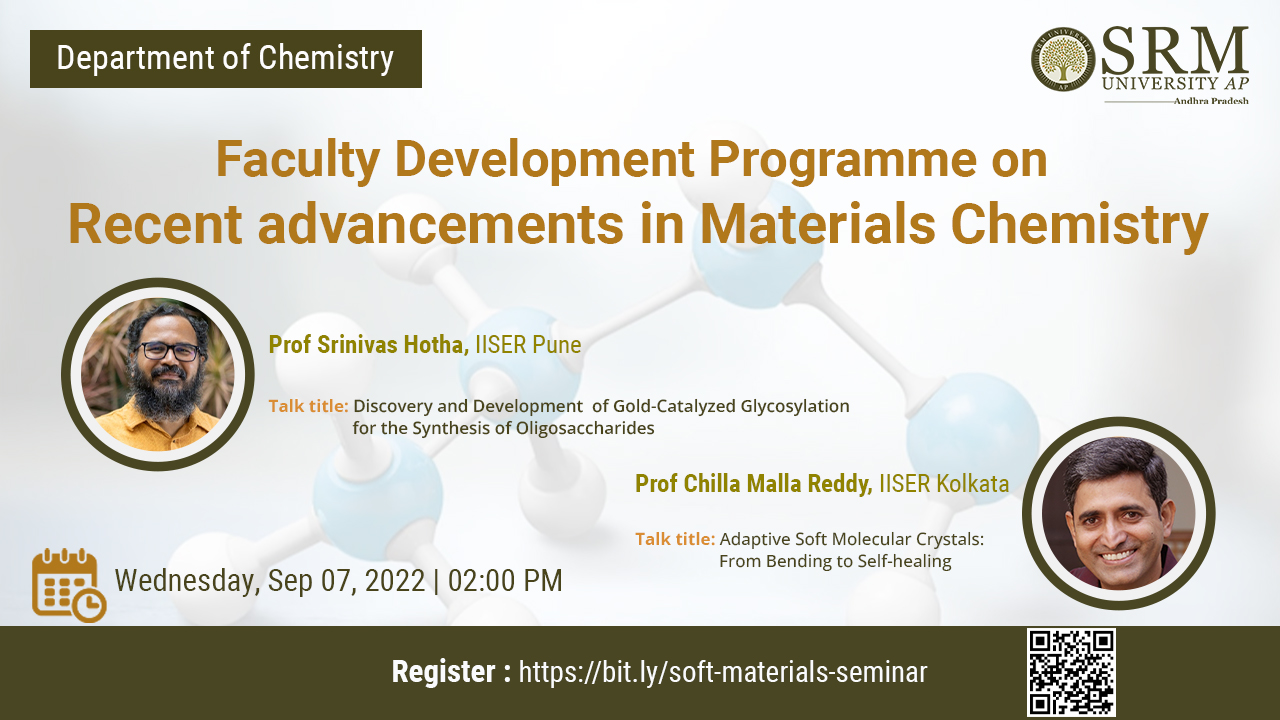 Material Chemistry is rapidly emerging as a critical component of contemporary science. Due to its interdisciplinary nature, the field requires input from all diverse branches of Chemistry. The Department of Chemistry is organising a Faculty Development Programme on Recent advancements in Materials Chemistry. Renowned academicians Prof Srinivas Hotha, IISER Pune, and Prof Chilla Malla Reddy, IISER Kolkata, will be the programme’s keynote speakers.
Material Chemistry is rapidly emerging as a critical component of contemporary science. Due to its interdisciplinary nature, the field requires input from all diverse branches of Chemistry. The Department of Chemistry is organising a Faculty Development Programme on Recent advancements in Materials Chemistry. Renowned academicians Prof Srinivas Hotha, IISER Pune, and Prof Chilla Malla Reddy, IISER Kolkata, will be the programme’s keynote speakers.
Prof Srinivas Hotha will deliver a talk on Discovery and Development of Gold-Catalyzed Glycosylation for the Synthesis of Oligosaccharides, and Prof Chilla Malla Reddy will handle a session on Adaptive Soft Molecular Crystals: From Bending to Self-healing Assistant Professor Dr Nimai Mishra and DST – Ramanujan Fellowship Faculty Dr Satheesh Ellipilli are the convenors of the event.
Date: September 7, 2022
Time: 2 PM to 5 PM
About the speakers
Prof Srinivas Hotha is the Dean of Planning and Communications at IISER Pune. He is an expert faculty in Chemistry and Glycochemical Biology. He has more than 25 years of experience in the field of teaching and research. He completed his PhD at Osmania University, Hyderabad.
Prof Chilla Malla Reddy is from the Department of Chemical Sciences of IISER Kolkata. He did his PhD in Supramolecular Chemistry and Crystal engineering from the University of Hyderabad. He continued his research as a post-doctoral fellow at Karlsruhe Institute of Technology, Germany. He has been awarded the prestigious Swarna Jayanti fellowship by the Department of science and technology, Government of India.
- Published in Chemistry-news, Departmental News, Events
Molecular design to store solar energy
 India has an ambitious target of achieving 300 GW of solar power by 2030. Conventional methods for producing solar power involve absorbing sunlight by a molecule and converting it directly into electricity. This is possible only during the daytime when sunlight is available. An interesting and complementary prospect is storing the absorbed solar energy by converting it into a different form of energy, such as chemical energy, which can then be transformed into electrical energy when sunlight is not available during the night-time.
India has an ambitious target of achieving 300 GW of solar power by 2030. Conventional methods for producing solar power involve absorbing sunlight by a molecule and converting it directly into electricity. This is possible only during the daytime when sunlight is available. An interesting and complementary prospect is storing the absorbed solar energy by converting it into a different form of energy, such as chemical energy, which can then be transformed into electrical energy when sunlight is not available during the night-time.
To realise this prospect, Assistant Professor Dr Baswanth Oruganti from the Department of Chemistry has designed a molecule that can absorb solar energy and convert it into the chemical energy of the bonds. His paper titled Modulating the Photocyclization Reactivity of Diarylethenes through Changes in the Excited-State Aromaticity of the π-Linker has been published in the Journal of Organic Chemistry, on Cover Page, with an impact factor of 4.2. He is both the first author as well as the corresponding author of the article. For this project, he has collaborated with Prof Bo Durbeej, Division of Theoretical Chemistry, Department of Physics, Chemistry, and Biology (IFM), Linköping University, Sweden.
Abstract
In recent years, the concept of excited-state aromaticity and its applications in photophysics and photochemistry has attracted considerable research interest. Our study uses quantum chemical calculations to systematically investigate if the photocyclization reactivity of diarylethene switches can be controlled by the excited-state aromaticity of the ethene bridge. Indeed, we demonstrate that these switches can be transformed from being highly reactive to completely non-reactive by changing the excited-state character of the bridge from anti-aromatic to aromatic.
Generally, molecules tend to move from a high-energy state to a low-energy state, as the lowering of energy increases the stability of the molecule and makes it chemically less reactive. In contrast, the present study shows that it is possible to chemically transform a molecule from a low-energy (aromatic) state to a high-energy (non-aromatic) state by absorption of light. This reaction occurs via a high-energy (anti-aromatic) electronically excited state of the molecule induced by light and has potential applications for storing solar energy in the form of chemical energy.
One challenge in the design of molecular solar energy storage systems, such as the diarylbenzene designed in the study, is that it is difficult to store solar energy for a longer period due to the instability of the newly formed chemical bonds at room temperature. To store solar energy for a longer period, one needs to compromise on the amount of energy stored in the bonds. In this regard, in the future, researchers are planning to optimise their molecular design by finding the right balance between the amount of solar energy stored and the time period for which it can be stored.
- Published in Chemistry-news, Departmental News, News, Research News
Highly-stable amine-free CsPbBr3 PNCs for display applications

The Department of Chemistry is glad to announce that Dr Nimai Mishra, Assistant Professor, along with his research group comprising PhD scholars, Syed Akhil, Manoj Palabathuni, Subarna Biswas, Rahul Singh, have published an article titled Highly-Stable Amine-Free CsPbBr3 Perovskite Nanocrystals for Perovskite-Based Display Applications in the journal ACS Applied Nano Materials published by the American Chemical Society, having an impact factor of 6.14.
Colloidally synthesised cesium lead halide (CsPbX3; X=Cl, Br, and I) perovskite nanocrystals (PNCs) often suffer from poor ambient and environmental stability conditions, limiting their practical applications. The commonly used surfactant oleylamine is converted to oleylammonium cation, which pulls out the halide anion from the PNCs surface, thus disrupting the nanocrystal’s structural integrity and stability.
The research group has developed a simple, completely amine-free colloidal synthesis with a hot injection method in open-atmospheric conditions and introduced bromooctane as a bromine precursor to overcome the above issues. These, as synthesized amine-free PNCs, showed a photoluminescence quantum yield (PLQY) of around 60 %, and the size of PNCs is ~25 nm. Moreover, these amine-free PNCs were highly stable in the colloidal solution and thin films for more than five months in ambient conditions, with 66% of its initial PLQY.
In addition, these PNCs have shown exceptional stability under different environmental conditions, with 44 % of initial PL even after 6 hours of water treatment and 28 % of initial PL under ethanol treatment for 120 minutes. Furthermore, it has exhibited excellent photostability for 96 hours and retained 36 % of its initial PL under ceaseless UV light irradiation at 365 nm (8 W/cm2). Additionally, these PNCs have good stability upon heat treatment and maintained 34 % of initial PL upon heating up to 90 ºC.
The research team has also successfully fabricated the green-emitting down-conversion LED using these amine-free PNCs. Thus, they visualize that these amine-free CsPbBr3 PNCs are perhaps the ideal candidates for perovskite-based display applications.

- Published in Chemistry-news, Departmental News, News, Research News
Doctoral scholar secures visiting fellowship

Exposure to international research opportunities promotes empirical learning at an impeccable level. International research ventures aid scholars to explore novel research avenues enabling a transformative progress for society through the field of science. The Department of Chemistry is glad to announce that Ms Jayasree K, PhD scholar, has been accepted for Short-Term Research Internship (STRI) for a period of six months from the Research Center of Environmental Medicine, Kaohsiung Medical University, Taiwan.
Ms Jayasree has been elevated in receiving the offer and delightfully keen on the new avenues she could explore through this opportunity. She is currently working in the field of surface-enhanced Raman spectroscopy (SERS). In this particular research area, her major research objective is the design and development of a novel SERS substrate for food and bioanalysis.
“My internship mentor, Prof. Vinoth Kumar, KMU University is an expert in mass spectroscopy and High-performance liquid chromatography (HPLC). Therefore, I have an option to hyphenate the Raman technique along with mass spectroscopy which leads Raman research to the next level for various applications”, commented Ms Jayasree on this incredible opportunity.
Her internship at Kaohsiung Medical University (KMU) is based on the motive of research on food and environmental toxicity which would provide guidance on her first research project in the field of food analysis.
She has offered her sincere gratitude to her supervisor, Dr Rajapandiyan JP, Department of Chemistry for his constant support and advice from the application process to proposal writing, experimental planning etc. She also thanked SRM University- AP in providing support through the process and extending travel allowance and guidance.
Ms Jayasree utilizes this great opportunity to explore and discover herself, developing both personally and professionally. Through this internship she hopes to learn new skills, expand her knowledge in the field of research and explore career options in Taiwan.
- Published in Chemistry-news, Departmental News, News, Students Achievements
SERB- SURE Grants: 10 projects worth 2.50 crores awarded to SRM AP
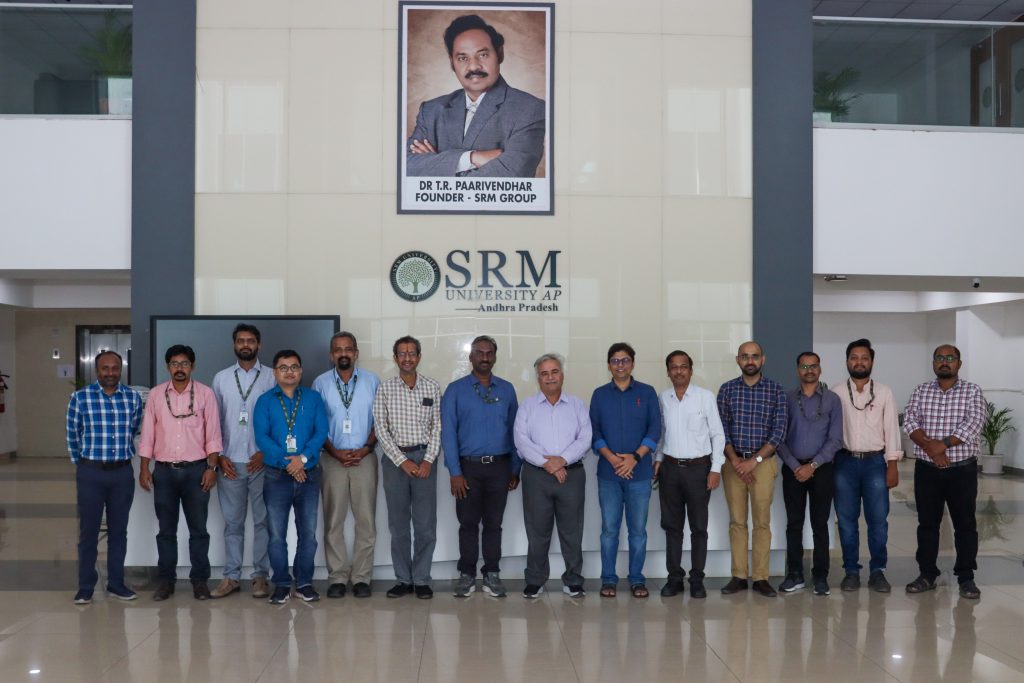
The faculty of SRM University-AP have been awarded 10 projects worth 2.50 crores from the Science and Engineering Research Board (SERB-SURE). Department of Science and Technology (DST) received a total of 2000 proposals, of which 466 were sanctioned. Among the 466 projects, 151 projects were awarded to Private Universities. Of the 151 projects approved to state private universities and colleges throughout India, the five-and-a-half-year young varsity was awarded 10 projects. 10 professors from various Science and Engineering Departments brought this incredible achievement to the university.
SERB-SURE is a research grant scheme initiated by the Science and Engineering Research Board (SERB) in India to provide financial support to young researchers in the early stages of their careers. The grants are intended to support research in basic and applied sciences, engineering, and technology and is typically granted for a period of three years.The SERB-SURE scheme is one of several initiatives by SERB to promote scientific research in India and support the development of a strong research community in the country.
“It is a milestone achievement that resonates with the University’s unparalleled commitment for excellence. We are striving towards research-intensive learning to build cutting-edge innovation for a transformative tomorrow”, commented Vice Chancellor, Prof. Manoj K Arora. The Executive Director-Research of SRM Group, Prof. Narayana Rao said that, “SRM University-AP has travailed hard to achieve the world-class scientific temperament that we now advocate, and this achievement is a testimonial recognition of all our efforts.” The prestigious grants were sanctioned to the faculty in the on-going domains of Quantum Kinetic Approach, Antimicrobial Resistance (AMR) Profiling and Changing of Hydroclimatic conditions in Bay of Bengal among 7 others.
Dean-SEAS, Prof. Ranjith Thapa said, “These research could be path-breaking and could offer a solution to many of the societal difficulties.” Prof. Jayaseelan Murugaiyan, Dr Sandeep Singh and Dr Pitchaiah Cherukuri of the Department of Biological Sciences; Dr Sabyasachi Chakrabortty, Dr V S Baswanth Oruganti of the Department of Chemistry; Dr Debabrata Pramanik, Dr Ravi Kumar and Dr Pankaj Bhalla of the Department of Physics ; Dr Sandeep Kumar Verma of the Department of Mathematics; Dr Uma Maheswar Arepalli of the Department of Civil Engineering; and Dr Kousik Das of the Department of Environmental Science and Engineering were awarded the grants.
- Published in Biology News, Chemistry-news, CIVIL NEWS, Departmental News, ENVS News, Math News, News, Physics News, Research News
Raman Signals Emitted by Pathogenic Vibrio Microorganisms and Purine Metabolites: A Comprehensive Analysis
Dr Rajapandiyan Panneerselvam, Assistant Professor, Department of Chemistry, and his team have developed a method using a portable Raman spectrometer to quickly identify six common pathogenic Vibrio species that can contaminate seafood. His latest research paper Intelligent convolution neural network-assisted SERS to realise highly accurate identification of six pathogenic Vibrio, has been published in the Q1 Nature Index journal Chemical Communications, having an Impact Factor of 6.0.
 By using gold-silver nanoparticles, the study was able to accurately detect these harmful microorganisms. The new deep learning model called a convolutional neural network (CNN), outperformed traditional machine learning methods with a classification accuracy of 99.7%. The entire identification process only took 15 minutes. The researchers also discovered that the Raman signals emitted by Vibrio species are similar to signals from certain substances found in purine degradation, such as uric acid and adenine. This knowledge helps them explain why different Vibrio species produce slightly different Raman signals. Overall, the CNN-assisted Raman spectroscopy method offers a fast and accurate way to diagnose and identify harmful microorganisms responsible for food contamination.
By using gold-silver nanoparticles, the study was able to accurately detect these harmful microorganisms. The new deep learning model called a convolutional neural network (CNN), outperformed traditional machine learning methods with a classification accuracy of 99.7%. The entire identification process only took 15 minutes. The researchers also discovered that the Raman signals emitted by Vibrio species are similar to signals from certain substances found in purine degradation, such as uric acid and adenine. This knowledge helps them explain why different Vibrio species produce slightly different Raman signals. Overall, the CNN-assisted Raman spectroscopy method offers a fast and accurate way to diagnose and identify harmful microorganisms responsible for food contamination.
Abstract
The utilisation of label-free Surface-Enhanced Raman Spectroscopy (SERS) technology enabled a comprehensive analysis of the connection between Raman signals emitted by pathogenic Vibrio microorganisms and purine metabolites. Through extensive research, a sophisticated Convolutional Neural Network (CNN) model was developed, demonstrating exceptional performance with an accuracy rate of 99.7% in the rapid identification of six common pathogenic Vibrio species within a mere 15-minute timeframe. This breakthrough offers a groundbreaking approach to pathogen identification, introducing a novel and efficient method to the field.
Practical Implementation of the Research
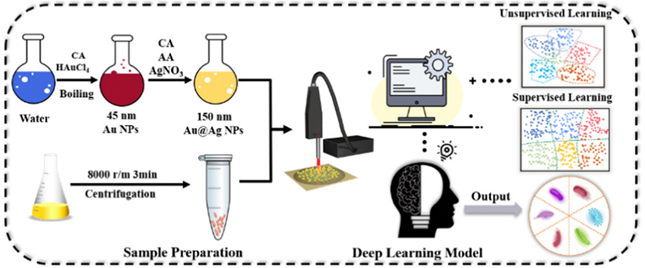 The practical implementation of label-free SERS technology combined with a deep learning CNN model enables rapid and accurate identification of pathogenic Vibrio microorganisms. This has important social implications, including improving public health and safety by quickly identifying and controlling outbreaks, enhancing food safety measures, and enabling real-time pathogen detection in resource-limited areas. The method’s speed and accuracy contribute to more informed decision-making, mitigating the spread of infectious diseases and ultimately creating a safer society.
The practical implementation of label-free SERS technology combined with a deep learning CNN model enables rapid and accurate identification of pathogenic Vibrio microorganisms. This has important social implications, including improving public health and safety by quickly identifying and controlling outbreaks, enhancing food safety measures, and enabling real-time pathogen detection in resource-limited areas. The method’s speed and accuracy contribute to more informed decision-making, mitigating the spread of infectious diseases and ultimately creating a safer society.
Future Research Plans
Moving forward, future work in the field of label-free SERS technology for pathogen identification could focus on expanding the coverage to include a wider range of Vibrio species, increasing the diversity of the dataset used for training, conducting rigorous cross-validation and external validation studies, exploring integration with portable SERS devices for on-site detection, optimising the deep learning model for speed and efficiency, and investigating clinical and environmental applications. By pursuing these avenues, the research can further enhance the versatility, reliability, and real-world applicability of the method, leading to improved methods for rapid and accurate pathogen identification in various domains.
Collaborations
- Dr Jianfeng Li (College of Materials, State Key Laboratory for Physical Chemistry of Solid Surfaces, College of Chemistry and Chemical Engineering, College of Energy, School of Aerospace Engineering, Xiamen University, Xiamen 361005, China)
- Dr Lin Zhang (State Key Laboratory of NBC Protection for Civilian, Beijing 102205, China)
- Dr Zehui Chen (Xiamen City Center for Disease Control and Prevention, Xiamen 361005, China)
- Published in Chemistry-news, Departmental News, News, Research News

